The following blog was originally written by Darren Bradley and published on his website to highlight his time in Abu Dhabi. Darren was a participant in a week long cultural delegation to the UAE, organized by the Embassy of the United Arab Emirates and Meridian International Center. The delegation consisted of public figures, art collectors and select museum and gallery professionals from around the United States.
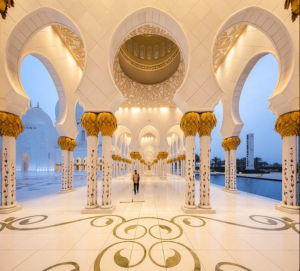
So I finally got the chance to visit the United Arab Emirates. I know I have a bit of a reputation for traveling all over the place, so some people may be surprised that I had never been before. And considering all of the architecture happening in Abu Dhabi and Dubai these days, there’s really no excuse, I know.
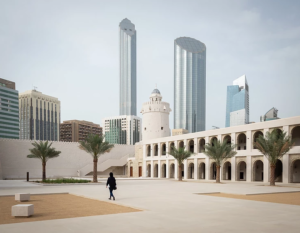
To be honest, there are lots of places I wanted to go. Yes, it was on my list, but it wasn’t at the top of my list. I had seen photos like everyone else. But I wasn’t sure it was really my vibe… I guess I saw it as a sort of “Las Vegas of the Middle East”. I’m not really a big fan of the real Las Vegas, either. Still, when I got an invitation to visit the country, I accepted enthusiastically. If I’m going to go someday, what a better way to go than as an invited guest of the host country? Turns out, most of my pre-conceived ideas about the place were wrong. It’s amazing and quite fascinating!
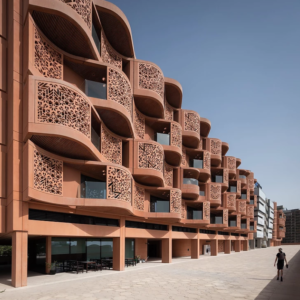
So a few months ago, I got an invitation out of the blue from an organization based in Washington, DC called the Meridian International Center. They asked if I was interested in being part of a cultural delegation of artists and art professionals to visit the UAE, as invited guests of the UAE Embassy in Washington. My first thought was: “Is this for real?” My second thought was: “Have they mistaken me for someone else?”
A little googling revealed that Meridian works with the US State Department and various other countries to facilitate cultural, political, and economic exchanges. They were established in 1960, and have been doing lots of programs of this sort since then. I assumed they would eventually get back to me and apologize for the mistaken identity, retract the invitation, and that would be that. So before that could happen, I quickly accepted and packed my bags.
The itinerary revealed a fairly packed seven-day tour, with a mix of contemporary art fairs (we would be there during Art Dubai and the Sharjah Biennale), museums (Louvre Abu Dhabi, Jameel Art Center…), cultural institutions (Sheik Zayed Grand Mosque, Etihad Museum), and other points of interest. I was a bit concerned, because I’m hardly an expert on contemporary art. I also noticed that most of the other delegates came from the art world. Nothing wrong with that, but it’s not really my scene and I wasn’t sure I’d have much to contribute.
This fear was reinforced when I met up with the three other members of the LA/So Cal contingent of our group in the Etihad lounge at LAX on the flight out there. They all moved in the same circles and shared the same friends, so immediately began throwing out names of people they knew in common and artists and galleries and such in a flurry that made my head spin.
Turns out, though, everyone was extremely nice and instantly made me feel welcome. The organizers – from Meridian and the UAE Embassy in Washington, DC – did an amazing job of facilitating the meetings, and everyone there was also fantastic.
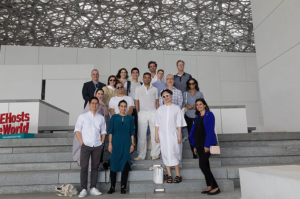
Abu Dhabi is the capital of the UAE and the largest of the seven Emirates that make up the country. Most of the government administrative functions are located there, but it’s really got a bit of everything.
Each Emirate has a very distinct identity, look and feel. Abu Dhabi is mostly a string of coastal islands, linked with bridges (at least the city is that way…). The Emirate is a combination of desert and mangroves/reclaimed marshland along the coast. It was beautiful and not too hot when we were there, although I understand that temperatures can get very high in the summer… with unbearable humidity.
But enough yapping. I’m guessing you’re not here for a history or geography lesson, let’s look at some architecture.
Masdar City
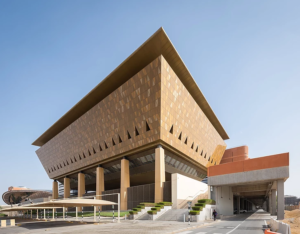
Our first day was mostly free and not everyone had arrived yet, so I decided to explore Masdar City with one of the other guys on the tour, Australian photographer and artist George Byrne.
Masdar City is planned community in the desert about 10 miles outside of the city of Abu Dhabi, near the airport. It was designed by Foster & Partners. Foster’s design team started its work by touring ancient cities such as Cairo and Muscat to see how they kept cool. Foster’s team found that these cities coped with hot desert temperatures through shorter, narrower streets – usually no longer than a couple hundred feet in length. This has the effect of pushing hot air upwards and creating corridors of cooler air and shade within.
Buildings in this region also have heat chimneys, which can carry the heat from the buildings up and out, and capture cooler air from breezes above.
You see them in nearly every traditional building in the region…
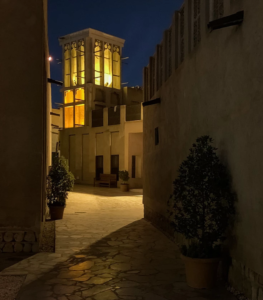
Masdar applies these principles in several ways. The city has thick terracotta walls decorated with traditional arabesque patterns to shield the buildings from direct sunlight and warm winds. There’s also a wind tower modelled on traditional Arab designs sucks air from above and pushes a cooling breeze through Masdar’s streets.
The site is raised above the surrounding land to create a slight cooling effect. Buildings are clustered close together to create streets and walkways shielded from the sun. The result is that the temperature in the streets is generally 15 to 20 °C (27 to 36 °F) cooler than the surrounding desert.
Also, vehicular traffic is generally restricted to the lower level, away from pedestrians. Most locals know Masdar for the little, driverless pod cars that shuttle people around the community.
The terracotta-colored buildings also incorporate a modern interpretation of traditional Arabic balconies and patterned screens, called mashrabiya.
Construction began on Masdar City in 2008 and the first six buildings of the city were completed and occupied in October 2010. However, the global financial crisis which nearly sunk neighboring Dubai also took its toll in Abu Dhabi. The ambitious plans were scaled back considerably, and also delayed. The final phase was supposed to be completed in 2015, but has now been pushed back to 2030 at the earliest. Of the 50,000 people and 1,500 businesses planned to occupy the site, only 2,000 people and a few businesses currently occupy it, including a university.
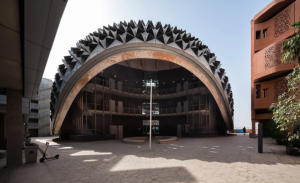
The university, which is a branch of the local Khalifa University, seems to be the largest current occupant of the site.
There’s one major corporate tenant, as well, Siemens…
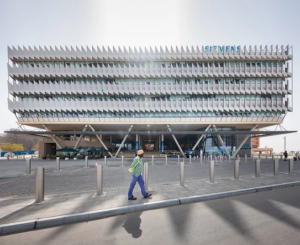
Ferrari World
I also had enough time to check out Ferrari World while I was there. Yes, Abu Dhabi has a Ferrari-themed amusement park. It’s on Yas Island, which is billed as “the Entertainment District” of Abu Dhabi. The complex also includes a water park, an absolutely gigantic shopping centre, and of course, a Formula One racetrack that holds a Grand Prix race every year.
Anyway, back to Ferrari World. You access it from the neighboring shopping mall. Like the mall itself, Ferrari World is absolutely ginormous.
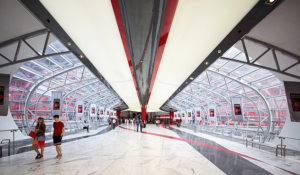
Oddly, it actually feels smaller inside than from outside. Usually, it’s the other way around with domed buildings – they tend to feel larger inside.
Emiratis love shopping malls, yes. This is stating the obvious. And yes, partially it’s because they have a lot of disposable income and they enjoy spending it in malls. But also, it’s because they are air conditioned, and in many months of the year, it’s really the only way to escape the heat.
The same rings true for their amusement parks – many of which are actually also completely enclosed in giant, hangar-like buildings. That explains why Ferrari World is built this way.
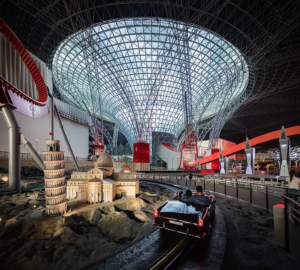
The Ferrari World structure itself is quite impressive. But to be perfectly honest, the inside felt a bit unfinished and sad inside. Several of the rides, including the main roller coaster, were down for maintenance indefinitely. And the place seemed a bit empty. The restaurants were all shuttered, too. There were little miniature Italian cities and landscapes throughout, but they seemed like they were made of papier mâché, and reminded me of a neighborhood miniature golf course. I was expecting something at least on par with Legoland inside, and this was not that at all.
There ARE a few actual Ferraris scattered around to look at, and that was the best part for me. I would have liked to see more. Some of them were actually just mock-ups, rather than actual cars. I was also hoping to get to drive a few, but none were available for that. Just karts…
There were several different gift shops scattered around, too, of course. I was hoping that at least one of them would be selling gear from other Formula One teams or other car marques, but no. All stores carried essentially the same exact Ferrari-branded clothing.
After my impromptu day on the “entertainment island” of Yas, we started our official tour on the “culture island” Saadiyat. Abu Dhabi is creating entire districts/islands with themes like those above. Saadiyat’s concept is still in its infancy, and will ultimately one day contain multiple museums and performing art centers by architects you’ve heard of, and other cultural institutions. For now, it really only has two that I saw: the Louvre Abu Dhabi and the Manarat Al Saadiyat.
The Manarat Al Saadiyat appears to have been originally intended as a visitor center and temporary exhibition space, until some of the museums like the Louvre Abu Dhabi and the new Guggenheim are built.
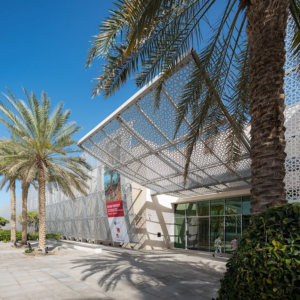
But it’s mission appears now to have grown, and it’s become a sort of museum and art center in its own right. Architect Richard Gluckman worked with the organizers to rethink the space and to create a series of exhibition spaces, but also a fantastic interactive art studio which holds workshops and also hosts artists in residence.
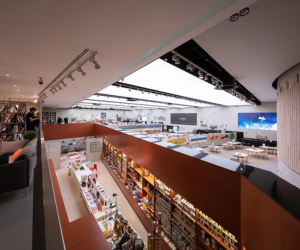
There’s also a restaurant and gardens. Like everything else there, it’s new and world class. All quite extraordinary. There was an exhibition there featuring an Emirati artist named Abdul Qader Al Rais that I really enjoyed.
We also did a tour of the Qasr Al Hosn, which is the oldest existing structure in Abu Dhabi. It’s the original fort and royal palace there. It was first built to protect the only fresh water well on Abu Dhabi Island. The first section was built in 1795, and then enlarged in 1939-45, during World War 2. But the timing of the expansion had more to do with the granting of the first oil license and the subsequent influx of cash than from the war. The complex has gone through an extensive restoration and only just re-opened.
A visit to the fort is the best way to realize just how far this country has come in such a short time. It’s really quite extraordinary to see what was accomplished in just half a century.
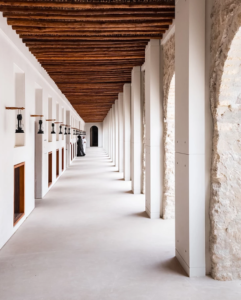
The old fort was once the tallest structure in the country, and is now surrounded by gleaming high-rises.
The royal quarters are very modest, by any standards.
Of course, being the artsy group that we were, we also made a pilgrimage to the national war memorial, which the Emiratis call “The Oasis of Dignity”, or the “Wahat Al Karama” in Arabic. It’s a large complex honoring those UAE soldiers who have fallen since the first policeman was killed in 1971 by Iranians while defending an island in the Persian Gulf.
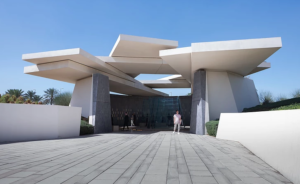
The artists in the group were particularly interested in seeing this place because of the beautiful monument that is the centerpiece of the site, a series of aluminum-clad panels called the “Leaning Pillars” created by the British artist Idris Kahn.
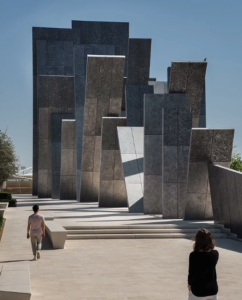
The whole experience was quite moving, and the sculpture is beautiful. So many memorials like the WW2 Memorial in Washington, DC have gone baroque and literal… I much prefer something more minimalist and abstract, like this one (or Maya Lin’s Vietnam Memorial in DC).
Sheikh Zayed Grand Mosque
And of course, no visit to Abu Dhabi would be complete without a visit to the Grand Mosque Sheikh Zayed, and was one of the highlights of the trip, as well.
The mosque was constructed between 1996 and 2007. It was designed by Syrian architect Yousef Abdelky.
The project was launched by the late president of the United Arab Emirates (UAE), Sheikh Zayed bi Sultan Al Nahyan. Rather than trying to create something characteristic of the local architectural vernacular, the Sheikh wanted a building that would include elements from all different parts of the Islamic world.
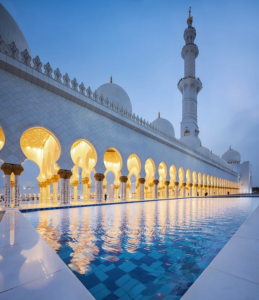
Photo ©Darren Bradley
To this effect, the design of the mosque incorporates elements from Persion, Mogol, Egyptian, Pakastani, Moorish, and other elements.
Besides its size, what stuns here is the level of craftsmanship, as the floral murals throughout are made with marble and precious stone, all hand carved and laid.
It’s hard to describe the scale of the place. Our guide told us it can hold more than 40,000 worshipers at one time. The carpet inside is apparently the largest single carpet in the world, and had to be sewn together in the building.
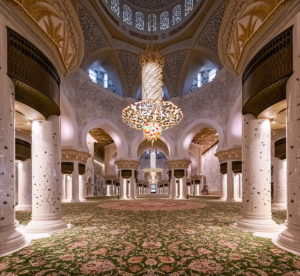
Al Ain
Several of us were also keen to see some sites that are a bit off the beaten path while in Abu Dhabi, so we took a side trip to the oasis town of Al Ain, on the border with Oman. This city has a special place in the hearts of Emiratis, as it is the ancestral home of the country’s ruling family.
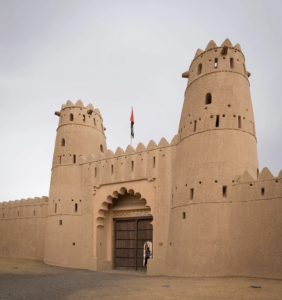
I hadn’t seen any photos of it before going, and honestly had romantic notions about the place… I was thinking it would be like something out of Indiana Jones, with ancient traditional souks and narrow streets lined with traditional sandstone buildings and tents.
What I didn’t realize is that Al Ain is actually the country’s fourth largest city. So while there is an actual date palm oasis garden in its center (there are actually seven of them), which includes a fort and a few mosques and other traditional buildings, it’s surrounded by a large, modern metropolis.
Regardless, we did appreciate the authenticity of the city, as many of the structures were a bit older and looked more “lived in” than many of the gleaming resorts and shopping centres we saw in the cities of Abu Dhabi and Dubai.
The main oasis is mostly a date palm plantation, with individual plots that are still privately owned and exploited. The place is a bit of a maze, and all of the streets tended to look similar.
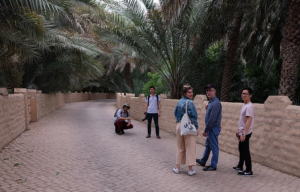
The Oases are irrigated through a series of underground canals with concrete channels above ground that can direct the water to different plots of land, called “aflaj“.
Next up, Part 2 in Dubai…
















